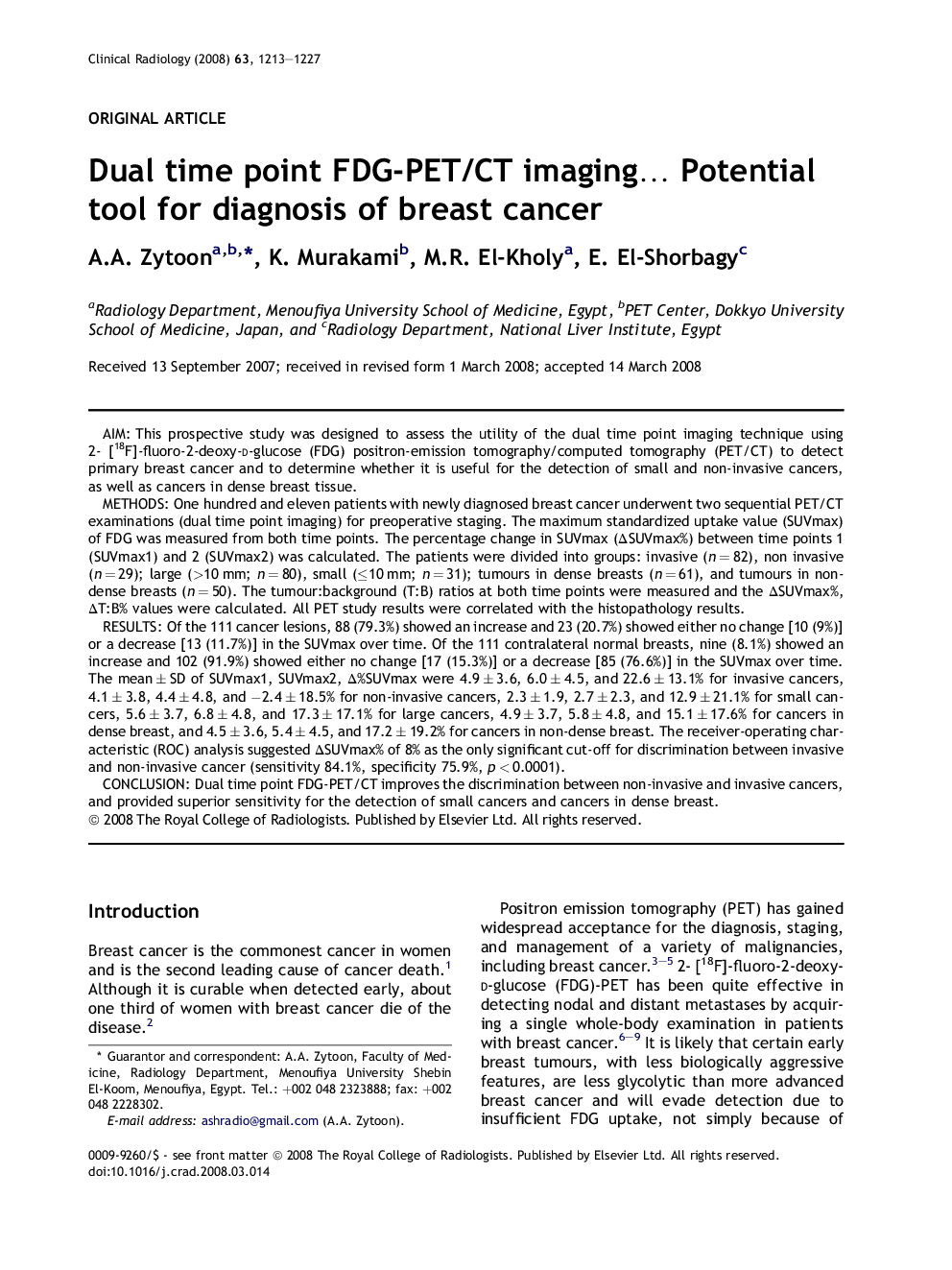| کد مقاله | کد نشریه | سال انتشار | مقاله انگلیسی | نسخه تمام متن |
|---|---|---|---|---|
| 3983124 | 1257752 | 2008 | 15 صفحه PDF | دانلود رایگان |

AimThis prospective study was designed to assess the utility of the dual time point imaging technique using 2- [18F]-fluoro-2-deoxy-d-glucose (FDG) positron-emission tomography/computed tomography (PET/CT) to detect primary breast cancer and to determine whether it is useful for the detection of small and non-invasive cancers, as well as cancers in dense breast tissue.MethodsOne hundred and eleven patients with newly diagnosed breast cancer underwent two sequential PET/CT examinations (dual time point imaging) for preoperative staging. The maximum standardized uptake value (SUVmax) of FDG was measured from both time points. The percentage change in SUVmax (ΔSUVmax%) between time points 1 (SUVmax1) and 2 (SUVmax2) was calculated. The patients were divided into groups: invasive (n = 82), non invasive (n = 29); large (>10 mm; n = 80), small (≤10 mm; n = 31); tumours in dense breasts (n = 61), and tumours in non-dense breasts (n = 50). The tumour:background (T:B) ratios at both time points were measured and the ΔSUVmax%, ΔT:B% values were calculated. All PET study results were correlated with the histopathology results.ResultsOf the 111 cancer lesions, 88 (79.3%) showed an increase and 23 (20.7%) showed either no change [10 (9%)] or a decrease [13 (11.7%)] in the SUVmax over time. Of the 111 contralateral normal breasts, nine (8.1%) showed an increase and 102 (91.9%) showed either no change [17 (15.3%)] or a decrease [85 (76.6%)] in the SUVmax over time. The mean ± SD of SUVmax1, SUVmax2, Δ%SUVmax were 4.9 ± 3.6, 6.0 ± 4.5, and 22.6 ± 13.1% for invasive cancers, 4.1 ± 3.8, 4.4 ± 4.8, and −2.4 ± 18.5% for non-invasive cancers, 2.3 ± 1.9, 2.7 ± 2.3, and 12.9 ± 21.1% for small cancers, 5.6 ± 3.7, 6.8 ± 4.8, and 17.3 ± 17.1% for large cancers, 4.9 ± 3.7, 5.8 ± 4.8, and 15.1 ± 17.6% for cancers in dense breast, and 4.5 ± 3.6, 5.4 ± 4.5, and 17.2 ± 19.2% for cancers in non-dense breast. The receiver-operating characteristic (ROC) analysis suggested ΔSUVmax% of 8% as the only significant cut-off for discrimination between invasive and non-invasive cancer (sensitivity 84.1%, specificity 75.9%, p < 0.0001).ConclusionDual time point FDG-PET/CT improves the discrimination between non-invasive and invasive cancers, and provided superior sensitivity for the detection of small cancers and cancers in dense breast.
Journal: Clinical Radiology - Volume 63, Issue 11, November 2008, Pages 1213–1227